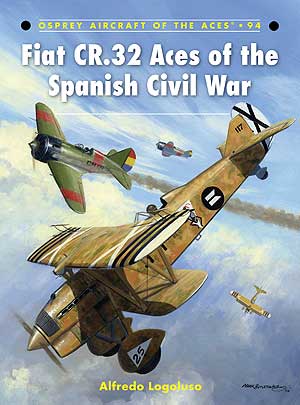
Camouflage of Italian military aircraft 1935-1945 is a subject interesting many researchers since about last 40 years, mainly associated to development of aircraft scale-model production and according to attention by specialized press and collectors, primarily referred to WW2.
No surprise so, that a literature exists on the matter, including authors devoted since long time to this kind of research, looking for different sources and documents, historical photographic materials, industrial archives, original painted aircraft parts, memories by air force personnel.
As for many other matters, an important impulse to this particular knowledge is given by development of the web communication, offering specialized sites on aviation history and attached literature, again along references to dedicated press, scholar associations, scale-models marketing, etc.: by internet again, a community of people all around the world gives notable contributions about the subject, through letters, comments, reviews, forums and so on.
Consequently, new works including references to a discussed matter as the camouflage of historical aircraft are submitted to critical examinations by researchers who more-or-less agree, based on different experiences and opinions, with colour interpretation and reproductions given by authors and artists about presumed appearance of those aircraft.
Recently, I've prepared texts and colour-reference files, and collecting photographic documentation too, for title 94 of "Osprey Aircraft of the Aces" series: "Fiat CR.32 Aces of the Spanish Civil War", the subject being quite out of WW2 (and WW1) prevalent editing interest. In fact, it was the first series title entirely devoted to the period "between the Wars". It's a project conceived since 2000-2001, realized by 2008-2009, to be published now in 2010.
According to the standard format and realization schedule of the series, that parts regarding references for colour-tables were completed first, aircraft "profiles" being meanwhile commissioned to Richard J. Caruana, one of the best aviation historical artwork makers and designers, with professional experience in the field dating about 40 years.
Space limitations due to the book standard format (96 pages - including 24 for titles, contents list, colour tables, appendices with scale-drawings and index) also reduced aircraft colours commentary, nothing being reported about my parallel research on finish, camouflage and markings of the considered machines.

The present writing therefore notes some information regarding colours and camouflage of CR.32s in Spain during 1936-1939, as contextually collected between 1975 and 2010 while studying International participation and air operations in the Spanish Civil War.
National markings evolution, unit emblems and tactical symbols, command badges and particular signs, identification codes and factory numeration applied to the aircraft are not considered here, these elements having been anyway comprehensively examined for identifying and dating of photographic documents.
Uniform light finish of first CR.32s sent to Spain is confirmed by photographic evidence about aircraft shipment, unload, assembling and beginning operations by August-September 1936.
A rare colour photo taken in September 1937 shows the contrast between silver overall finish and copper-yellow radiator ring on a line-up of uncamouflaged CR.32s (reference for profile 1 of colour tables in the book): this was the case for first CR.32s operating in Spain by 1936 and also later, when rad-rings remained partially or totally uncamouflaged for a while, sometimes after replacement of that part (Picture 1, as presented in the book too: profiles 1, 2, 3, 4, 6, 8, 15, 28, 30).
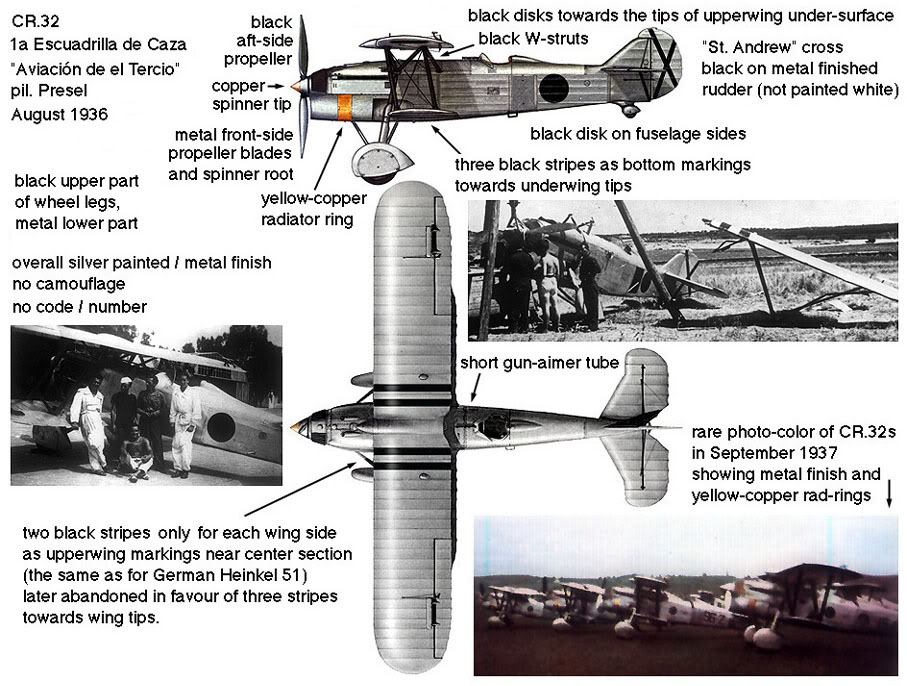
Picture 1
In continental Spain only, the first camouflage scheme applied to CR.32s, since September 1936, was obtained by irregular and more-or-less linear or narrow and shaded reddish-brown patches/mottles, on more-or-less uniformly painted sand-yellow upper-surfaces: in fact, during September-October 1936, green was not yet applied. This was because CR.32 first major operations in central Spain started from Caceres base, a terrain (with no tree nor grass) where abundant red dust covered aircraft in hot and dry climate conditions, prevalent colours of local summer landscapes also being mainly of reddish and yellowish tones.
References about early camouflage come especially from fighter pilots contacted by this writer, as Generali Adriano Mantelli and Giuseppe Ruzzin, who independently confirmed this two-colour scheme applied to first CR.32s in continental Spain during September-October 1936: Mantelli remembering the camouflage origins precisely from Caceres' reddish dust and Ruzzin reporting (letter to the writer, 20 March 2001) about camouflage for CR.32s shipped along with him:
"When the third expedition arrived at Cadiz on 12 October 1936, our CR.32s were painted silver as in Italy, the same aircraft being soon repainted by yellow and maroon patches, following the fancy of operators: unfortunately, paint was granular, so reducing speed at least 5 Km/h; later paint turned out of better quality, almost shiny".This means that "yellow" or "sand-yellow" and "reddish-brown" or "maroon" paints initially used for CR.32 camouflage in Spain were probably non-standard aviation materials, nor corresponding to later standardized colours for military aircraft finish, being instead paints of uncertain production and origins, may be made in Spain (for general purpose), or in Italy, or somewhere else too.
Green patches or mottles, with more-or-less shaded edges, began to be added or applied later to camouflage of CR.32s operating in continental Spain (during winter 1936-37, from bases near Torrijos where olive-trees and greater plants were present), this being also remembered by Generale Mantelli and confirmed by b/w photographic documentation, showing till four different "grey-tones" on camouflaged CR.32 surfaces, corresponding respectively to silver (clearest, uncovered parts), yellow, red, green (the latter appearing generally the darkest tone on b/w photos; an example is in Picture 2 - reference for colour profile 6).
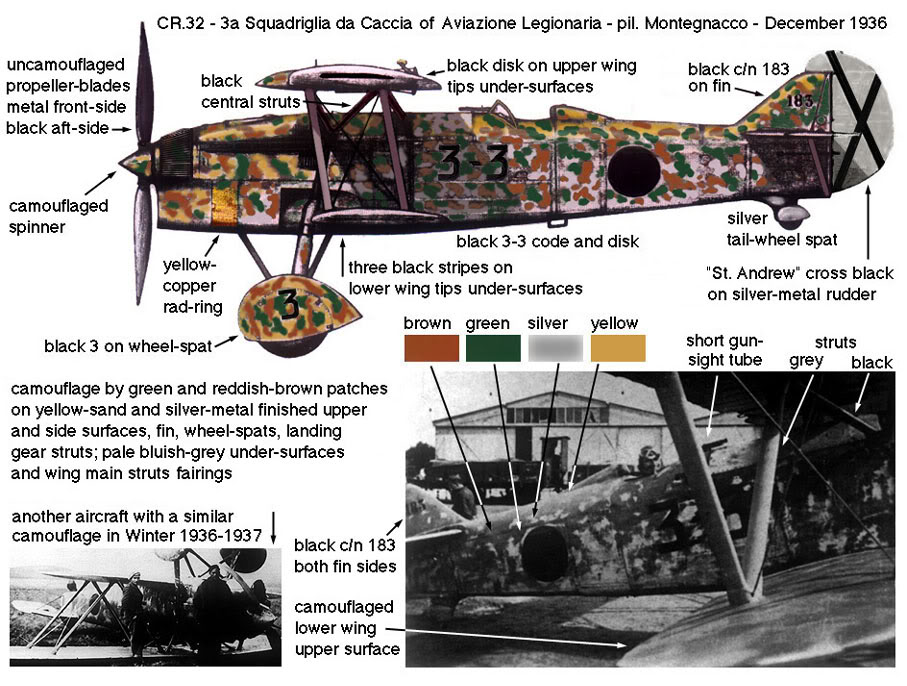
Picture 2
Early examples of green mottled or patched camouflage applied along with (or upon) silver and yellow painted upper- and side-surfaces are in profiles 7 and 8, or photos on pages 32, 33, 34, 37 in the book. An example of camouflage applied in January 1937 is in Picture 3 - reference for colour profile 7.
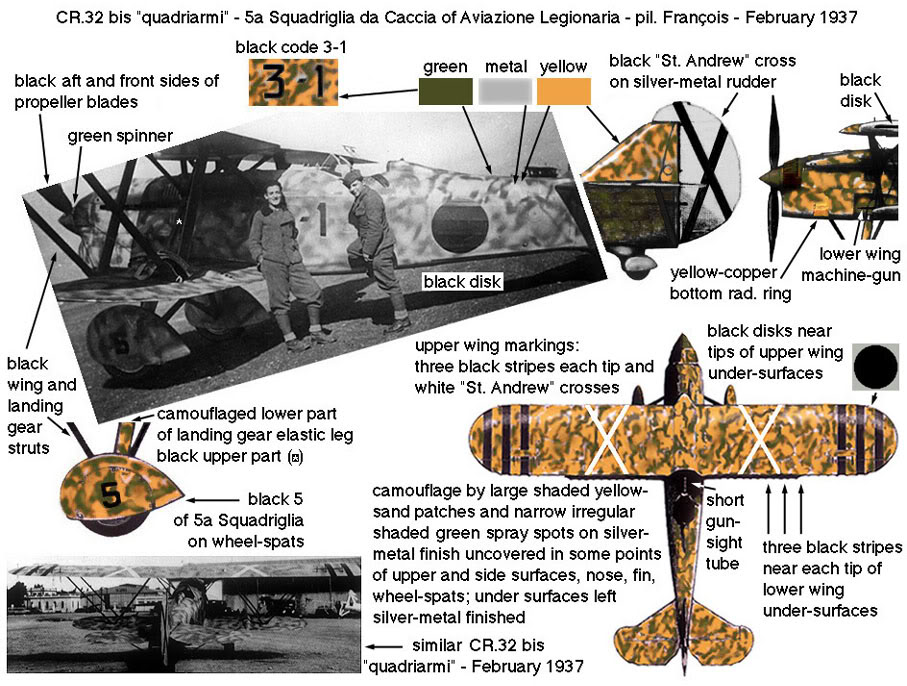
Picture 3
As remembered also by Generale Mantelli (letter to the writer, 8 February 1976):
"Our CR.32s, initially aluminium-finished, were camouflaged according to colours of operational areas in so far as upper surfaces are concerned, while under-surfaces were painted bluish-grey".CR.32s based in Balearic Islands instead remained silver overall until Summer 1937, about half of these fighters keeping this so-called "aluminium-finish" later too (till towards the end of Civil War), some other however bearing the typical Italian "band-camouflage" scheme of 1936-'37, very rarely seen on CR.32s operating in continental Spain.
According to oral sources too, since end 1936 - beginning 1937 at least two basic green paints were in use to integrate CR.32 camouflage in Spain: a greyish-green and a darker olive-green (the latter more frequently applied). These could be both general purpose paints (also used for vehicles, railway wagons, etc.) or among early paints imported from Italy and destined to military aircraft camouflage. In fact, by winter 1936-'37 paints used in Italy for the so-called "band-camouflage" were quite widely available and applied also by FIAT factory at Turin where CR.32s were produced, this set including at least five colours: light-yellow or sand-yellow, maroon or reddish-brown, brown or dark-earth, greyish-green or sage-green, dark-green or olive-green. There were also a sixth colour used for upper- and side-surfaces camouflage - a light-earth or ochre-yellow (apparently more used by different Italian aeronautical firms than by FIAT) - and a pale-bluish-grey generally destined to paint aircraft under-surfaces.
Bluish-grey and ochre-yellow were also introduced in Spain for CR.32 camouflage by late 1936 and beginning 1937 respectively, so by spring 1937 there were at least six basic colours available for upper- and side-surfaces painting (aluminium-silver, reddish-brown, sand-yellow, ochre-yellow, greyish-green, olive-green) and two colors for under-surfaces (aluminium-silver and bluish-grey), independently from considering different origins or purposes (and different tones eventually) of applied paints.
This anyway cannot yet explain the extreme variety of camouflage colours (and schemes) applied to CR.32s in continental Spain during Civil War 1936-'39, as the same can only be known by intuition examining hundreds of historical photos, films, relics, etc.
In fact, it has to be noticed that apart from physical or optical variations introduced by different kinds of photographic films and processing (as orthochromatic or panchromatic negatives, showing different "grey-tones" mainly for yellows and reds in b/w photos), said extreme variety in camouflage colours and schemes was also due to three general causes other than availability of several basic paints, so that it's possible to observe b/w historical photos and movie-frames of CR.32 flying formations or line-ups on the ground, taken in Spain (and shortly later in Italy too), presenting - in the same light conditions - each aircraft out of three or four or more machines camouflaged in a different way if compared to all the others: may be such an exceptional variety interested no aircraft but the CR.32 in Spain, among all combat planes and conflicts in the aviation history. (As a direct and contrasting comparison, almost all first-line fighters by Spanish Republican side - these being hundreds of I-15 biplanes and I-16 monoplanes both main CR.32's opponents - had unvaryingly and uniformly green painted upper- and side-surfaces, according to Soviet VVS standard 1936-'39 and memories of both Republican and Nationalist airmen, with very few known or hypotized exceptions).
The further three general causes (but also exalted in the case of CR.32 in Spain) of so great camouflage variety were: paints preparing modalities, applying techniques and wear or attrition.
Preparation interested both dilution with solvents and mixtures of basic paints, while application was executed both by brush and spray-devices (the latter more frequently used and an evident reason of changeable finish), all factors influencing the final appearance of painted surfaces: colours intensity, dullness, shaded effects, etc.
In so far as service wear or attrition is concerned, it is sufficient to imagine two aircraft presenting similar camouflage colours beginning operations: the first one seen after three weeks flying during battle of Brunete on advanced airfields of central Spain in July 1937, with up to 40oC in the shade and turbulent dust acting as glass-paper; the second machine flying for three weeks, six months later, during battle of Teruel in Aragon - local coldest winter since 1900, till 40oC below zero or much less at flight altitude, often the aircraft being covered by iced snow both in the air and on the ground. At the end, colours should appear quite different if compared each other and each one different with respect to the initial status too.
Moreover, often even parts of the same aircraft (wing and fuselage, port and starboard wing-planes, tail-fin and stabilizer, ailerons or wheel-fairings, etc.) appeared painted by colours and camouflage schemes different each other, this mainly depending on repair and frequent part substitutions operated by unit technical services, but also on existing extreme paint variety.
Re-painting of the CR.32s in Spain was also quite frequent, this not only, or not mainly, because geographical- and winter- or summer-camouflage were more-or-less prescribed or applied (both within Italian or Spanish units), but evidently owing paint wear or attrition, more than other motivations. And this also should explain because much of the aircraft painting was applied on the field and within air-units, instead of at factories and depots. By the latter, CR.32s were also re-painted after repair, overhaul, reconstruction, etc., surely giving the aircraft some better degree of camouflage uniformity or standardness, at least by time to time, more complying with some seasonal or geographical prescriptions about camouflage.
For instance, CR.32 NC 262 (initially coded 3-17 and later 3-51), often photographed during the Civil War because most used by leading ace García Morato, received at least six different two- and three-colour camouflages (possibly eight) during a period of about 30 months, this meaning an average of one re-painting after four-five months service, which could be about the same for other CR.32s in Spain, within both Spanish and Italian units.
With the increasing organization of Nationalist technical services and air-parks, such as the main establishment at Seville in the Southern Spain and Logroño in the North, some camouflage uniformity became more frequent, especially when new CR.32s arrived from Italy to Seville-Tablada where aircraft were assembled and prepared before assignment to new units.
Anyway, during operational service and maintenance at unit-level, initial uniformity more-or-less rapidly disappeared.
As remembered, since the beginning of air operations and before the end of 1936, yet camouflage of CR.32s in Spain was at least recommended according to landscape colours and seasons, but photographic evidence and analysis on dated images and especially field-conditions variety show that a true standardization about this matter was never completely achieved, apart from some generalized increasing of finish uniformity towards the end of Civil War, during 1938-'39.
Instead, a further kind of disuniformity developed along prosecution of the Spanish war, this depending also on separated service modalities among Italian and Spanish units, and within the same Aviazione Legionaria, among generally separated action performed by different fighter Gruppi.
Different applications of colours and schemes can also be noted not only between Italian and Spanish units in camouflages of its respective CR.32s: there were evident finish differences even among the Italian Gruppi themselves operating in continental Spain.
No wonder of this, because, for instance, even different combat concepts and "battle formations" were separately developed by “Cucaracha”, “Asso di Bastoni” and “Gamba di Ferro” Gruppi in Spain (an interesting article on this matter being published by Italian Rivista Aeronautica in May 1940, written by an ex-25a Squadriglia’s CO, Capitano Enrico Meille, who served in Spain during 1938-'39).
However, differences mainly associated to single Italian and Spanish units are not envisaged here in detail, a general view on the subject being considered only (some examples are anyway reported in the book: profiles 19 and 20 representing similarly camouflaged aircraft of XXIII Gruppo Caccia, end 1937 - early 1938, according to a scheme generally different from those of the other Groups).
Moreover, particular camouflage schemes were also tested by Italians on their CR.32s in Spain (unpublished photographic evidence existing too).
This writer also had an enlightening interview with a former member of Aviazione Legionaria, Maresciallo Giuseppe Gorini (met in Lucca, Tuscany, in 1985), an armourer also charged of CR.32 camouflage painting within 25a Squadriglia of XVI Gruppo Caccia "Cucaracha", who served as a Sergente in Spain from February 1938 until February 1939 at operational bases of Mas de las Matas, Caspe and Vendrell, in order (Picture 4 shows an example of four-colour camouflage scheme applied by spring 1938 to an aircraft from 25a Squadriglia flown by CO of XVI Gruppo Caccia, Maggiore Armando François - reference for colour profile 26 in the book).
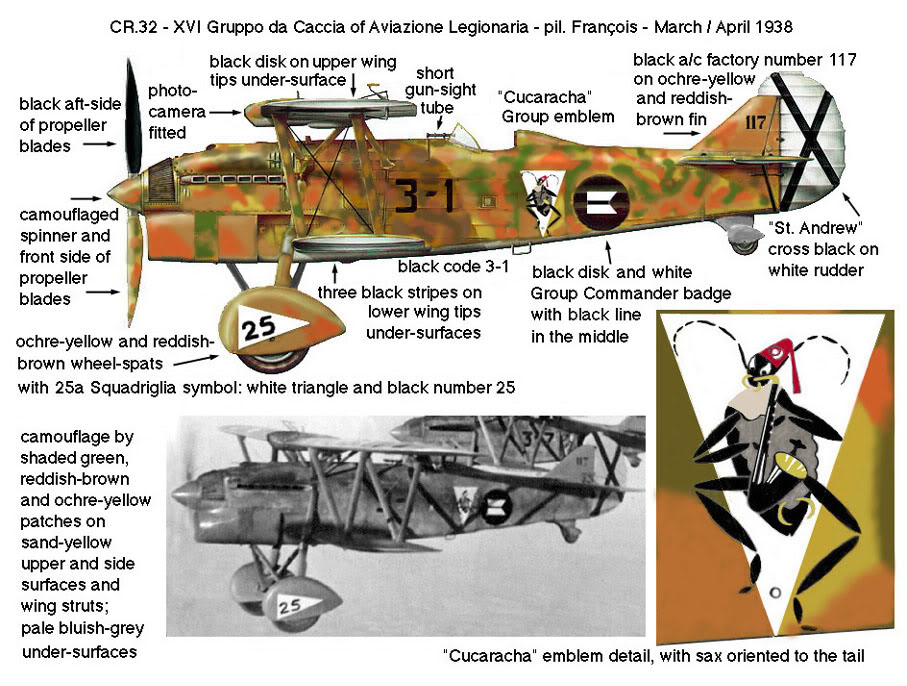
Picture 4
Although reporting on the last year of war, when in general ground crews of CR.32 units applied something more a camouflage standardization with respect to former period 1936-'37, Gorini too remembered the great colour variety presented by those aircraft he helped to paint and re-paint, within his first-line unit operating from advanced bases where supplies of secondary maintenance materials were far to be regular: often, basic colour-paints available to camouflage first-line CR.32s were mixed in changing proportions, results being mutable tones and colour gradations. Even mixes among intended upper- and under-surfaces colours were possible (for instance, upper- and side-camouflages including sometimes bluish-grey paint during 1938-'39, both within Italian and Spanish units).
Starting from a set of five or more basic colour-paints, applying combinations of two, three or sometimes four different colours on the same aircraft, adding mixtures of two or more different basic colour-paints in variable proportions and varying camouflage schemes, all these and other differences in painting techniques, as by brush or spray-devices and paints more-or-less diluted or shaded, resulted again during 1938-'39 into a great variety for CR.32 finish, as before seen in Spain since 1937.
Anyway, during 1938-'39 a tendency to standardization appeared, mainly within Spanish CR.32 units and partially among Italian fighter Gruppi based in continental Spain, in so far as the background camouflage colour is concerned (and may be also more often in accordance with a warm-season or cold-season painting standard).
The basic difference was application of sand-yellow (paler) or ochre-yellow (darker) as background colour for CR.32 upper- and side-surfaces (the first colour initially intended for summer and the second one for winter periods). Camouflage was then completed by more-or-less shaded and extended patches applied on the uniformly painted background: green patches only (two-colour camouflage) or green and maroon patches (three-colour camouflage).
Again these four basic colours (sand-yellow, ochre-yellow, olive-green, reddish-brown) presented some variability, probably less accentuated going towards the Civil War end.
And again variations should be considered too, for instance: olive-green background with yellow (and maroon) patches/mottles, greyish-green background or patches/mottles, bluish-grey also used as upper- and side-surfaces colour-paint for background and/or patches/mottles, etc.
Looking at b/w photos, an useful method to check sand-yellow (pale) or ochre-yellow (darker) colour-paints applied to the aircraft is a direct comparison with "grey-tones" corresponding to personnel flesh complexion (faces, hands, etc.) as seen near to the painted surfaces, when taken in the same light conditions. Another useful comparison can be made with "grey-tone" given by standard Italian "Marus" flying-jacket (pale-brown) widely used by both Italian and Spanish airmen, several examples still existing as reference specimens.
Sand-yellow "grey-tones" appear comparable with "grey-tones" given by the pale flesh complexion of white race persons (Caucasians, more-or-less tanned); for example in the book: photos on pages 13, 17, 19, 20, 27, 30, 34, 37, 38, 40, 41, 43, 47, 48, 49, 51, 64, 65, 70, 73, 74, 75, 81. Colour profiles presenting quite extensive sand-yellow upper- and side-surfaces are: 8, 9, 10, 12, 13, 14, 17, 19, 20, 24, 25, 28, 30, and 31.
Ochre-yellow "grey-tones" appear darker than flesh "grey-tones" of white race persons; for example: photos on pages 52, 82, 84 (showing personnel from left: with pale, intermediate and dark flesh face complexions) and 85 in the book. Also, examples of CR.32s camouflaged without sand-yellow paint and by ochre-yellow background are in photos on pages 66, 72, 77, 80 - (another example being reported here in Picture 5: a CR.32, later in 1938 flown by CO of 24a Squadriglia, Capitano Giuseppe Majone, with background of upper- and side-surfaces painted ochre-yellow, which "gray-tone" appears evidently darker than flesh "grey-tone" of the Italian airman having his hand on the forward fuselage, and lighter than standard "Marus" flying-jacket; instead, olive-green camouflage patches appear darker than flying-jacket). In the book, colour profiles presenting quite extensive ochre-yellow upper- and side-surfaces are: 18, 22, 24, 27, 29, 32, 33, and 34.
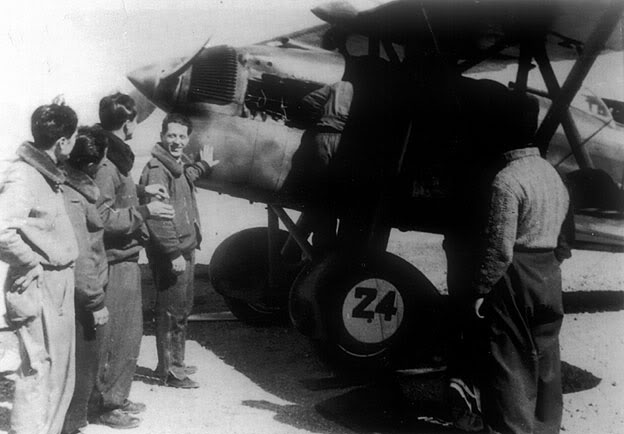
Picture 5
The CR.32 at Cuatro Vientos
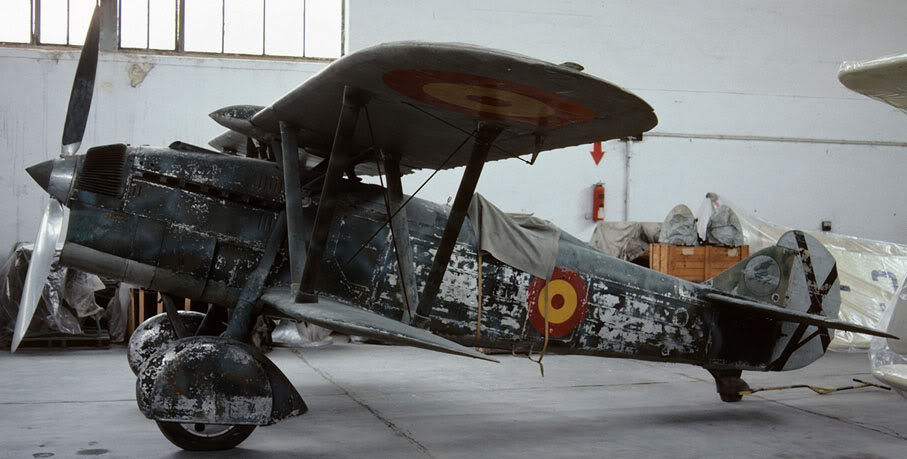
Picture 6 (www.modelbrouwers.nl)
Picture 6 shows it in 1975, before restoration (assembled by parts of different aircraft): traces of sand-yellow background paint and olive-green shaded patches were visible on the tail fin (reported from CR.32 NC 262, code 3-51, most flown by J. García Morato within Grupos 2-G-3 and 3-G-3 during the Civil War), while on fuselage and other parts appeared a particular three-colour shaded-patches camouflage: bluish-grey, olive-green, dark-brown (under-surfaces were pale-bluish-grey).
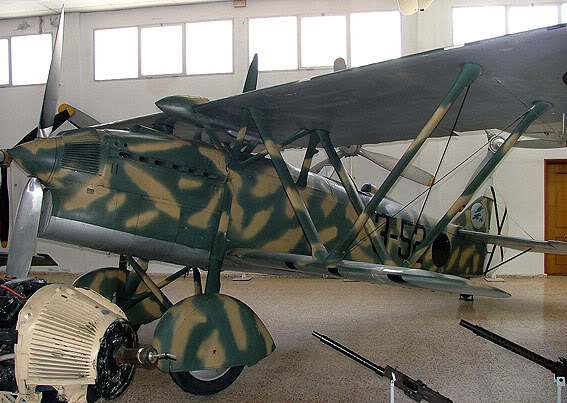
Picture 7 (www.lasegundaguerra.com)
Picture 7 shows this CR.32 of after restoration (1988): painted as CR.32bis NC 508, code 3-52 (previously 3-13 flown by J. Salvador Díaz within "Patrulla Azul" beginning 1937 and then passed to Grupo 2-G-3, finally in service after the Civil War end) camouflaged by a particular two-colour scheme: olive-green background and not much shaded ochre-yellow patches, under-surfaces being aluminium-silver finished.
The CR.32 at Vigna Di Valle
Between 1956 and 2003, HS C.R.32 quater NdF 328 presented in Italy six different camouflages, in sequence:
1) A two-colour scheme of Spanish origin (ochre-yellow background and olive-green shaded patches);
2) A two-colour scheme of Spanish inspiration (sand-yellow background and olive-green not much shaded patches);
3) A two-colour scheme of Spanish inspiration (olive-green background and sand-yellow shaded patches);
4) (Picture 8) a three-colour scheme of Spanish inspiration (sand-yellow, olive-green and reddish-brown shaded patches);
5) (1976-2003) a three-colour scheme of Spanish inspiration (sand-yellow background with not much shaded olive-green and brown patches);
6) (Picture 9) a two-colour scheme as imitation of a Spanish camouflage (light-yellow background and pale-green shaded patches, so-called "low-contrast" paint).
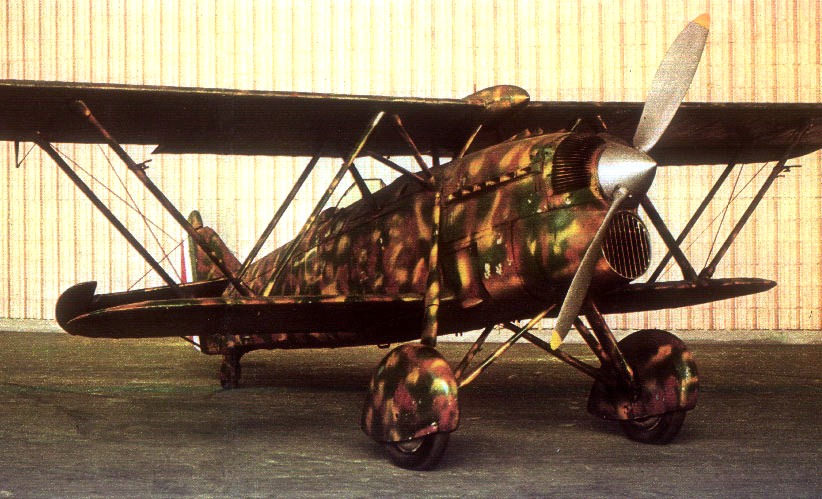
Picture 8 (A. Mondadori archive)
Picture 8 shows the CR.32 of Vigna di Valle (HS C.R.32 quater NdF 328) at Turin in 1970, before final restoration, camouflaged by a three-colour shaded-patches scheme applied after its shipment to Italy in 1956: sand-yellow, reddish-brown, olive-green and aluminium-silver under-surfaces - a camouflage of Spanish Civil War inspiration, also applied to RA’s CR.32s since 1938-39.
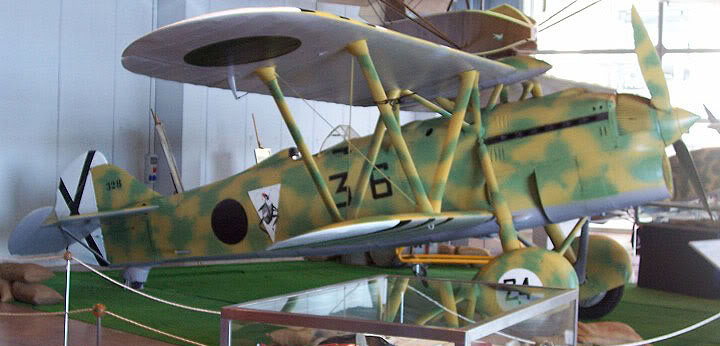
Picture 9 (fotoalbum.virgilio.it)
Picture 9 shows the CR.32 after 2003 restoration, painted as an aircraft of 24a Squadriglia, XVI Gruppo Caccia "Cucaracha", coded 3-6 with number 328 reported on the fin, so keeping the Hispano Suiza’s Numero de Fabricación as an Italian FIAT CR.32’s Numero di Costruzione (actual aircraft taken as a reference for this restoration, CR.32 ter coded 3-6 within 24a Squadriglia at the end of 1937, had NC 720) and camouflaged by a two-colour scheme: light-yellow background with pale-green shaded patches and pale-bluish-grey under-surfaces.
Notes on “Osprey Aircraft of the Aces – 94” colour tables Colour references for tables presented in the book resulted also from independent research of mine, trying to put in evidence both camouflage variety (with respect to periods, air-units, operational theatres, etc.) and a general lack of precise relationship between colours applied to CR.32s in Spain and so-called "standard paints" more-or-less prescribed for aircraft of Regia Aeronautica in Italy since September 1937 (mimetic-yellow, -maroon, -green) and later by 1938-'39 (more colours added to the set, again mainly according to Spanish continental experience).
References (examples being reported here in Pictures 1 to 4) and colour tables files for the book were prepared by computer-graphics, working on monitor images only, final effects in colour-print bringing to some darker tones. Moreover, some discrepancies can be noted:
- Profiles 10, 12, 13, 14, 23, 30, 31, 35, 36: quite brown-like patches should be olive-green (as reported by colour plates commentary);
- Profiles 21, 35, 36: ochre-yellow background should be darker;
- Profile 26: reddish-brown patches should be dull.
Obviously however, any mistakes existing in the Osprey’s book about aircraft colours and camouflage schemes interpretation are under responsibility of this writer only, and in no way they could be ascribed or associated to the highly professional and strict artwork prepared for publication.
© 2010 Alfredo Logoluso
